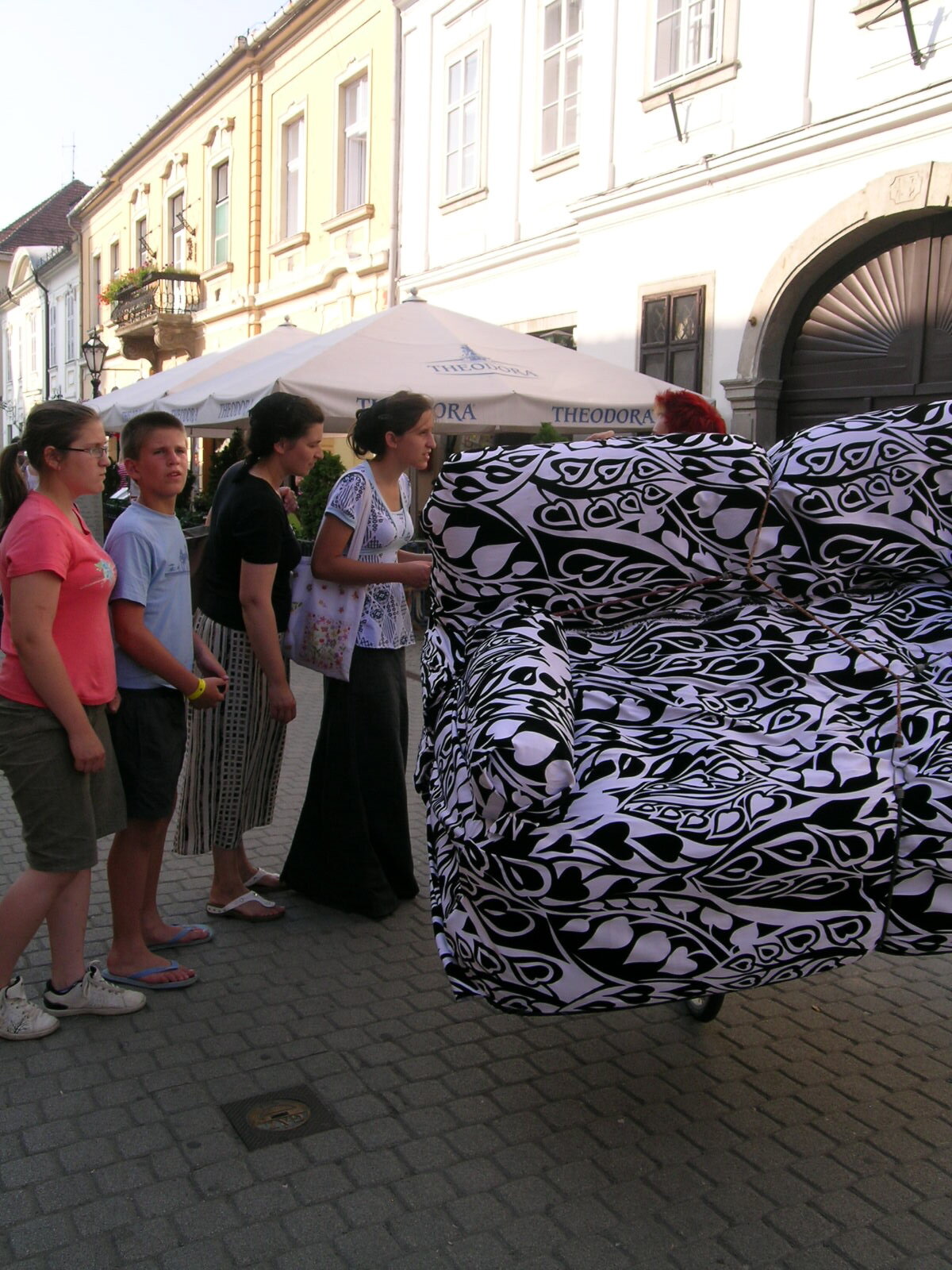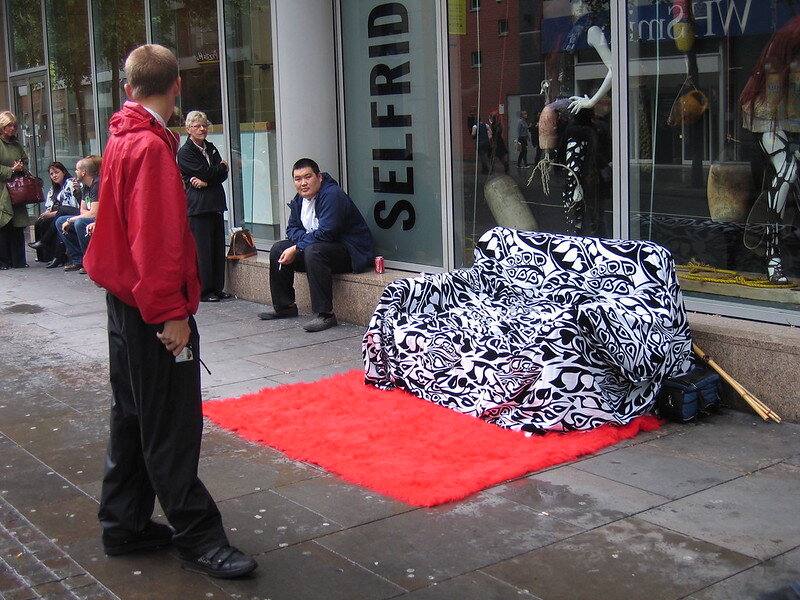the Sit-u-ationist Sofa
Eger, Hungary
It’s a flock-covered, plush, inflatable sofa
which I strap to the back of my bicycle and take around the city, setting it down, with a red shag rug in front of it, in different public spaces, to engage passers-by in conversation and dialogue.
I’ve taken the Sofa to a number of places, cities such as Bristol, Manchester, Wolverhampton, Eger (Hungary) and Breda (Netherlands). With the sofa I continue my interest in investigating how we can create more of a continuous sense of play and improvisation within our daily lives and in public spaces. The idea of the Sofa builds on a number of strands from contemporary and past practice and theory: on Situationist interventions in urban space, on themes of participatory art as discussed by Grant Kester and Claire Bishop, on ideas for flexible urban design by Constant Nieuwnhuys, and on the past designation of public space as commons, where people would carry out a wide range of activities including grazing animals, selling and trading goods and materials, conversing and playing. The Sofa’s purpose is to provoke a visual interruption, by literally, changing the fabric of the city from hard to soft; to engender discussion and dialogue around themes of community, urban design, and participation; and to encourage the idea of creating playful everyday spaces within an urban setting.
I was reading Jane Jacobs, Mike Davis, Ken Knabb and more Rebecca Solnit (Hope in the Dark,) making trips to the British Library to get as close as possible to the original writings of the Situationists. I was interested in Debord’s idea that he set out in Potlatch #1:
Sit-U-ationist Sofa
“In accordance with what you are seeking, choose a country, a more or less populated city, a more or less busy street. Build a house. Furnish it. Use decorations and surroundings to the best advantage. Choose the season and the time of day. Bring together the most suitable people, with appropriate records and drinks. The lighting and the conversation should obviously be suited to the occasion, as should be the weather or your memories. If there has been no error in your calculations, the result should satisfy you.”[1]
Participation begins here.
I’d seen street arts practitioners set up a living room or similar sets outside but I wanted something more stripped down that wasn’t pretending to be a living room, but that would interrupt our everyday notions of what should be on the street. I came up with the idea of moving a sofa around the city and stopping every now and then to rest and provide a place for conversations to happen. But I would then rely on others to help me, which, if they were passers-by would be another kind of intervention. There were also logistical problems of storage, the problem of castors (which are notoriously unreliable) and weight. I then thought that if I could transport it by bike that would make it tourable all over the place. My housemate suggested an inflatable sofa. Fantastic! it came in a small rucksack-size bag and inflated to a grand two-seater sofa. Its first outing was to the TRIP[2] conference in Manchester in June 2008. I travelled up a few days beforehand, deciding to make covers for it, because its navy colour was a little dull. After being in touch with Morag Rose, founder of the Loiterers Resistance Movement (LRM) in Manchester, who told me there was a brilliant fabric store in Oldham Street, I decided to take a chance on making loose covers from suitable fabric there. She was right. I chose a black and white flock fabric for the covers and supplemented this with a red shag rug to put in front of it. This was for me a real interruption of the concrete and brick fabric of the city, as well as being eye-catching.
With cunningly arranged bungee cords I strap the inflated sofa onto the back of my folding bike pack the covers and rug into the side panniers and was off. I usually need a bit of help loading the onto the bike so that starts off the participation right there and then.
As soon as I was on the road I realized I was creating interruptions in people’s assumptions and expectations – of what could travel on the road, of what could be seen in the city, and of what could be carried on the back of a folding bike (at a distance it was impossible to tell it was inflatable.) What was more, I was not in costume or wearing a funny hat, so it was not an obvious street theatre intervention. I felt it was more effective as an interruption in that it could not be readily categorized.
I choose a place to set it down, sit there and invite passers-by to have a rest, sit down, have a chat. Only does it become obvious that the pavements are often owned by the stores fronting onto them. Selfridges in Manchester moved me on.
It’s often easier to attract groups of passers-by obviously, and many younger ones would do it for a ‘laugh.’ Asked why I am doing this I explain about interrupting preconceptions of how space is used in the city and as a way to potentially get people to chat together who don’t know each other. The sofa is a little small to get more than three people at a time on it, which is the reason for the rug. I often chose to make sure I was the one who sat on the rug while others took up the sofa since I felt there was a bit of a power imbalance, exacerbated by my sitting up on the sofa.
The Sofa stimulates conversation and intervention from city officials/authorities has provoked interesting discussions on the subject of ‘liberty’ and ‘freedom’ amongst those of us gathered around it.
Although I make it clear that this is an intervention for the outside, I have been asked to bring the sofa to conferences and installations. It also necessitates more than a ‘day out.’ Thus in Wolverhampton[3] I had a day out in the city followed by a report back with documentation at the conference on the following day. I experience some discomfort in documenting this intervention, as with much of my work, because the work happens at the point of intervention, in the enactment. Nevertheless, in addition to documentation being a necessary element of the work for its further promotion, it is also important for the re-telling and remembering of such work, among participants as well as for those who did not experience the event.










